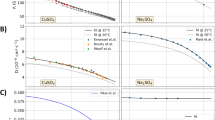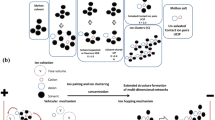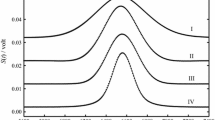Abstract
A novel liquid diffusion tube closed and cylindrical termed Diffusimeter was fabricated from glass tube and straight bore stopcocks to measure relative velocities of electrolytes in free diffusion. Solutions of two electrolytes known to give characteristic reaction were put one above each of two stopcocks and then released concurrently to diffuse head on through water in the diffusion path and finally to produce a precipitate or color as indicator at the encounter. Experimental objective required entry of time elapsed for the reaction mark to appear and the distances traveled by the electrolytes. The velocity ratio termed distance traveled ratio (DTR) was found to match with the Molar Mass Ratio Square Root (MMRSR) of the electrolyte pair taken in order. A direct proportionality between the velocity and the square root of molar mass was thus revalidated. The heavier electrolyte moved faster contrary to the gaseous diffusion. The results hinted hydration numbers of the diffusing electrolytes. Diffusion velocities of 30 salts were determined using this novel, innovative Diffusimetric Method named DTR model. Surprisingly NH4Cl and NH4SCN showed similar velocities. HCl and LiCl showed low diffusion rates due to their cations’ high charge to size ratio. Apparently MgCl2, CaCl2, and SrCl2 diffused with one H2O each but BaCl2, AgNO3, and FeIII alum with none. NaCl showed relatively high rate which traces its fitness as antibacterial agent and biosalt in human. Na2SO4 and K2SO4 showed identical velocities which together with metatheses hypothesize sylvite mineral formation mechanism over geological periods. Close diffusion rates of ZnCl2 and CdCl2 traces reasons for cadmium’s presence in zinc ores. Diffusion controlled effects are shown in FeIII salts’ reactions with NH4SCN; the DTR reveals reactant pair’s encounter nature at their conjunction. Manipulating electrolytes’ concentrations crystalline precipitates were obtained.
Access this chapter
Tax calculation will be finalised at checkout
Purchases are for personal use only
Similar content being viewed by others
References
Graham TH (1883) Philos Mag J Sci 175–191; 269–276; 351–358
Fick A (1855) Philos Mag 10:30
Narasimhan TN (2004) Fick’s insights on liquid diffusion. EOS Trans Am Geophys Union 85(499):501
Shaw DJ (1992) Introduction to colloid and surface chemistry, 4th edn. Butterworth and Heinemann Ltd., London, 26
Jacobs MH (1967) Diffusion processes. McGraw-Hill, New York, pp 13–74
Khair A, Golzar Hossain GM, Saiful Alam M, Zakir Hossain Shaheen M (2010) Bangladesh Patent, Int. Cl5 G01N 13/00, 1004924
Emsley J (1991) The elements, 2nd edn. Oxford University Press, New York, pp 88–106
Shriver DF, Atkins PW, Langford CH (1991) Inorganic chemistry. Oxford University Press, Oxford, p 608
Cotton FA, Wilkinson G, Gaus L (1987) Basic inorganic chemistry, 2nd edn. Wiley, New York, p 271
Cotton FA, Wilkinson G (1972) Advanced inorganic chemistry, 3rd edn. Interscience, New York, p 217
Matwiyoff NA, Taube H (1968) J Am Chem Soc 90:2796
Nakamura S, Meiboom S (1967) J Am Chem Soc 89:1765
Hatashi H, Sarkari M, Zeinali M, Zare Aliabadi H (2010) Austr J Basic Appl Sci 4:4766–4771
Lewis RJ Sr (1993) Hawley’s condensed chemical dictionary, 12th edn. Van Nostrand Reinhold, New York, p 1110
Cotton FA, Wilkinson G, Murillo CA, Bochmann M (1999) Advanced inorganic chemistry, 6th edn. Wiley Interscience, New York, p 605
King EL (1964) How chemical reactions occur. W. A Benjamin, New York, p 65
Partington JR (1965) A textbook of inorganic chemistry, 6th edn. ELBS and Macmillan & Co Ltd., London, p 784
Katakis D, Gordorn G (1987) Mechanisms of inorganic reactions. Wiley, New York, p 72
Wells AF (1993) Structural inorganic chemistry, 5th edn. Oxford Science, New York, p 444
Author information
Authors and Affiliations
Corresponding author
Editor information
Editors and Affiliations
Rights and permissions
Copyright information
© 2012 Springer Science+Business Media B.V.
About this chapter
Cite this chapter
Khair, A. et al. (2012). Novel Liquid Diffusion Tube Determines Electrolytes’ Relative Free Diffusion Velocities, Hydration Numbers and Overwhelmingly Revalidates Electrolytic Diffusion Law. In: Gupta Bhowon, M., Jhaumeer-Laulloo, S., Li Kam Wah, H., Ramasami, P. (eds) Chemistry for Sustainable Development. Springer, Dordrecht. https://doi.org/10.1007/978-90-481-8650-1_12
Download citation
DOI: https://doi.org/10.1007/978-90-481-8650-1_12
Published:
Publisher Name: Springer, Dordrecht
Print ISBN: 978-90-481-8649-5
Online ISBN: 978-90-481-8650-1
eBook Packages: Chemistry and Materials ScienceChemistry and Material Science (R0)




